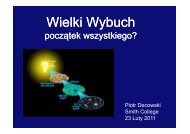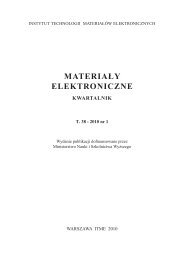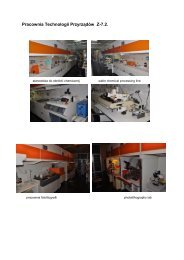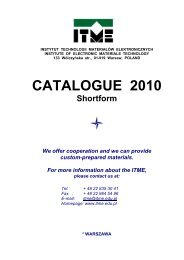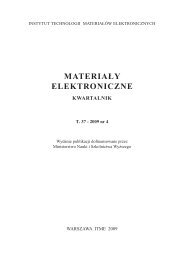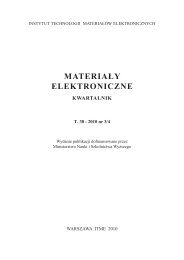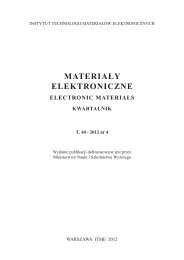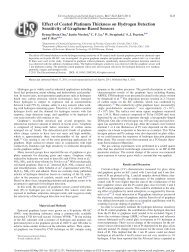Nr 1 - ITME
Nr 1 - ITME
Nr 1 - ITME
You also want an ePaper? Increase the reach of your titles
YUMPU automatically turns print PDFs into web optimized ePapers that Google loves.
transverse (TO) and longitudinal (LO) optical phonon modes, which are associated with<br />
asymetric streching the O-Si-O bonds as a function of the oxide film thickness provides an<br />
evidence that near the both interfaces exist region of sub-stoichiometric silicon oxide (SiO x ).<br />
The structure of this SiO x layer is different at each interface. We propose a model in which<br />
the sub-oxide layer in the SiO 2 //Si interface is composed with SiO 2 and Si. We found that the<br />
TO phonon frequency apparently starts to shift toward higher wave number at around 4,0 nm<br />
from the interface. The structure of this SiO x layer in the Si/SiO 2 interface is just the same as<br />
that observed for the thermal oxide. Spectroscopic investigations were performed for the<br />
oxide films range from 1,5 nm to 20 nm.<br />
OBJĘTOŚCIOWY, ROZLEGŁY, DWUWYMIAROWY KRYSZTAŁ FOTONICZNY<br />
Ireneusz Kujawa, Adam Filipkowski, Dariusz Pysz, Jędrzej Nowosielski, Ryszard Stępień<br />
Przerwa fotoniczna (Photonic Bandgap) jest optycznym odpowiednikiem występujących w<br />
półprzewodnikach pasm wzbronionych [1-4]. Pojawianie się pasm spowodowane jest<br />
występowaniem dyfrakcji Bragga fali świetlnej na periodycznej strukturze dielektrycznej<br />
jedno- dwu- lub trójwymiarowego kryształu fotonicznego. Przerwa fotoniczna określa zakres<br />
długości fali, wektorów falowych i modów, dla których światło nie może się rozchodzić – dla<br />
tego zakresu struktura o określonych parametrach dielektrycznych i geometrycznych jest<br />
idealnym zwierciadłem. Efekt ten wykorzystuje się w optycznych światłowodach<br />
fotonicznych PCF (Photonic Crystal Fiber) [5–8] do propagacji światła. Istnienie<br />
fotonicznych stanów wzbronionych jest uwarunkowane kontrastem współczynników<br />
załamania światła i stosunkiem ilościowym dielektryków wykorzystanych do budowy<br />
struktury oraz sposobem ich wzajemnego rozmieszczenia [1–11]. Ilustracją wpływu Δn na<br />
szerokość przerwy fotonicznej jest Rys. 1 przedstawiający wyniki przeprowadzonych dla<br />
λ = 1,55 μm symulacji powietrzno-szklanego sześciokątnego kryształu 2-D (przy d/Δ = const)<br />
dla szkła kwarcowego i kilku wieloskładnikowych szkieł, zależnie od ich współczynnika<br />
załamania.<br />
BULK, LARGE AREA, TWO-DIMENSIONAL PHOTONIC CRYSTAL<br />
Existence and size of photonic bandgap depends on the contrast of refractive indices of<br />
glasses used in manufacturing of the photonic crystal. For this structure contrast about 0.1 is<br />
possible to obtain. In such structures partial photonic bandgap exist, which means that<br />
photonic bandgap exists only for selected wave vectors. It can be used to shape and steer<br />
electromagnetic waves in function of wavelength change. Such commercial materials could<br />
find applications as beam splitters and couplers, wave filters, demultiplexers, low loss<br />
waveguides, and highly selective mirrors.<br />
A possibility of fabrication double glass photonic crystals is determined by a choice of pair of<br />
glasses with similar viscosity, melting temperature, thermal coefficients, and small diffusion<br />
(close to zero). Moreover glass has to be dedicated to multiple thermo-mechanical process<br />
without crystallization effects. Only glass that fulfils conditions mentioned above can be<br />
considered for such fabrications using a mosaic drawing method.<br />
In this article we described our works in manufacturing of large area (diameter in the order of<br />
1mm) and large height photonic crystal structures – a novel material for optic applications.




